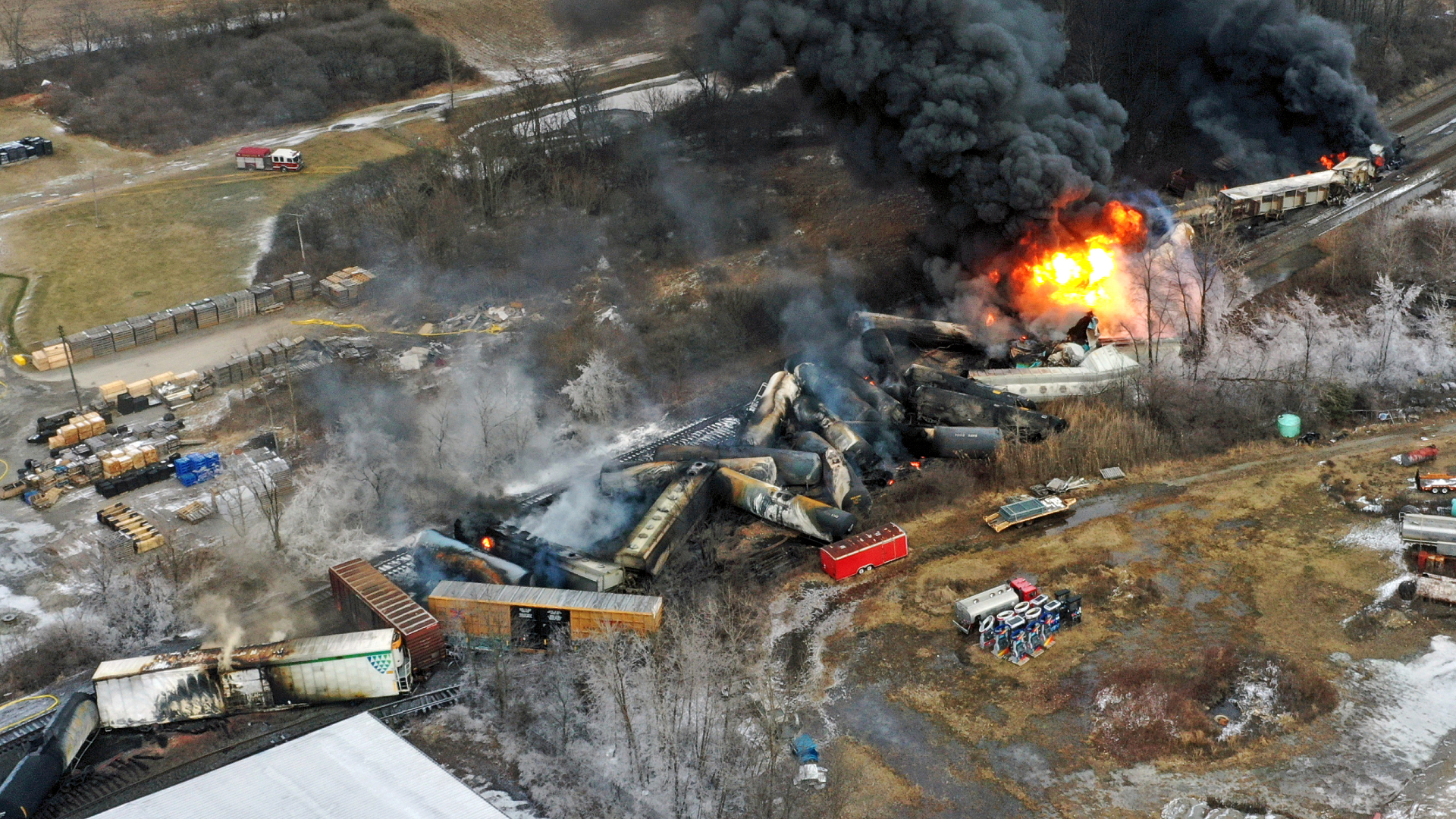Experts: No ‘abnormalities’ from Ohio train derailment detected so far in New York
It’s been nearly three weeks since a train carrying hazardous chemicals derailed in East Palestine, Ohio. Some residents say the response has been too little, too late. Now, an official in the Capital Region is raising concerns with the response.
NewsChannel 13 is working to get answers to viewers’ questions about the potential impact to New York and the Capital Region.
Experts said there had been no sign that the air quality in Albany is affected by the derailment and burning chemicals.
The New York State Mesonet monitoring system reported Tuesday that it had not picked up any ‘abnormalities’ in the air, according to a spokesperson for UAlbany.
Rensselaer County Executive Steve McLaughlin asked the EPA on Tuesday to set up air quality monitoring in the county.

In this photo taken with a drone, portions of a Norfolk Southern freight train that derailed the previous night in East Palestine, Ohio, remain on fire at mid-day on Feb. 4, 2023. (AP Photo / Gene J. Puskar, File)
In a statement, he said in part, “I am concerned there has not been more information forthcoming about the Ohio situation. The entire Northeast is exposed to the fallout from Ohio, and some guidance is needed.”
The New York State Department of Environmental Conservation said it had observed no human impact from the disaster. NewsChannel 13 asked for an interview Tuesday and was offered a statement saying the agency is closely monitoring any effects to the state’s air and water.
NewsChannel 13 spoke to Dr. Max Zhang, Professor of Mechanical Engineering at Cornell University whose area of research is in energy and environmental systems. Dr. Zhang said there was no indication of an impact on New York’s air, despite the state being downwind.
“What’s happening in Ohio, those are isolated, a short duration event, not as a big power plant, running 24/7, continuously, right,” he said. “So that’s why, even though locally residents have been affected […] based on what I understand so far, there’s no concern for accumulations.”
He explained that particles from the controlled burn did travel in the air, but became less concentrated as they spread.
However, rumors about an impact to New York continue to swirl on social media.
An expert in the decisions made in disaster situations, Dr. Amber Silver is an assistant professor at UAlbany’s Department of Emergency Management and Homeland Security. She said people likely will not know the true impact of the derailment – and how it will change people’s lives – for a while.
“The reality is that with these very short notice rapid onset events like a train derailment, it takes a while for the full picture to become clear, and I would argue that will probably take a while longer for us to have a full understanding of the full scope of impacts from the train derailment,” she said.
She said the best way to quiet fear and misinformation is for trusted leaders to provide good information. The difference with this event is the mistrust in officials charged with managing the response.
“It’s this very interesting dynamic where the individuals that we would rely on for misinformation management during a crisis like this are the same individuals that people don’t trust because of the nature of the crisis itself,” Silver said.
New York State DEC’s full statement offered to NewsChannel 13 is below:
“DEC takes impacts on state air quality very seriously, including those that occur outside of New York State with the potential for impacts within state borders. DEC is coordinating with the U.S. Environmental Protection Agency to monitor any potential impacts to New York State from the derailment and fire in Ohio, which was approximately 90 miles south-southwest of New York’s border with Pennsylvania. No human health impacts have been reported at this time.
Since the East Palestine fire, DEC meteorologists and air quality experts have been closely monitoring information about the fire and air flow patterns to determine if there was the potential for currents to impact New York air quality or cause deposition of particles from the train fire into New York communities. DEC experts are also analyzing samples being taken from DEC ambient air monitoring stations to identify any potential air quality anomalies. No anomalies have been detected at this time and monitoring is ongoing.
Deposition of particles can result from a number of factors, including industrial and transportation emissions sources, forest fires, dust storms and other localized conditions both within and beyond New York’s borders. Residents concerned about any unusual particles recently observed can provide DEC with a detailed report of conditions including photos or other evidence by calling the NYS Spill Hotline and DEC will take appropriate actions.
Public drinking water sources in New York State are rigorously and continuously monitored to ensure they are protective of public health. No New York State drinking water impacts from the Ohio incident have been reported to DEC. Information about public drinking water and private wells can be found on NYSDOH’s website- https://www.health.ny.gov/environmental/water/drinking/your_drinking_water.htm.”